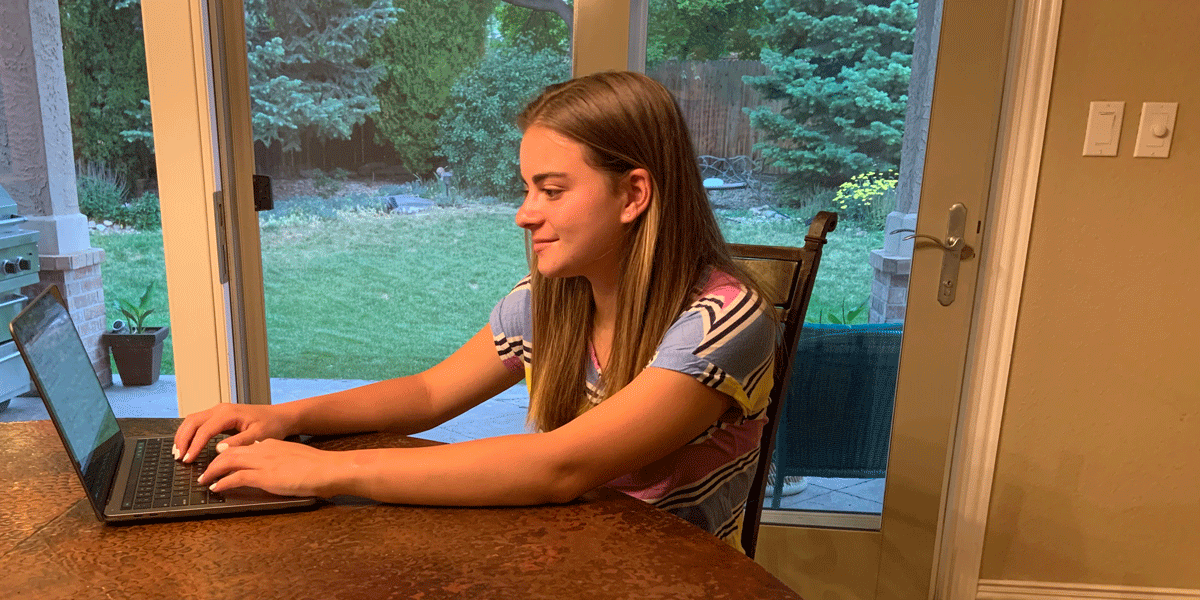When Dori Beck enrolled in Performance Innovations, led by Colorado Academy teachers Sean Gallop and Steve Scherer, she expected to be able to express her personal artistry and use Colorado Academy’s Innovation and Computer Science Labs to create and showcase performance art. By the third trimester in 2020, she was looking forward to the course’s capstone project, when students learn to program in Python and become proficient in robotics as they create CA’s version of the interactive art experience Meow Wolf.
Beck envisioned a project with hanging walls, showing how technology both brings people together and drives people apart. But when the COVID-19 pandemic struck, CA transitioned to remote learning immediately after Spring Break and all her plans had to be scrapped.
“I was sad,” Beck says. “I was looking forward to putting my final project together and doing normal school activities. But our teachers immediately changed the entire scope of the class and the projects we were doing.”
‘Miss one semi-colon!’
Working with Gallop, Beck started brainstorming ways she might illustrate how coronavirus spreads, comparing contagion in different states. She acknowledges that she had had “some exposure” to computer science in Middle School, but this was the first formal computer science course she had taken. Studying the Johns Hopkins coronavirus map, tracking coronavirus data published in the New York Times, and learning a visual Java-based language called Processing with the help of Mr. Gallop, she wrote code to animate how coronavirus spread, county by county, in four states: Colorado (see video above), Michigan, Washington, and Connecticut.
“After we transitioned to remote learning, Dori was one of several students in the class who really stepped up to learn advanced programming skills so they could work independently,” Gallop says. “In response to these students’ interests, we developed a five-week intensive class in Processing so they could fulfil their goals—in Dori’s case showing how dangerous this virus is.”
Beck says she loved learning how “computer science can be used in so many different ways,” forcing her to “change my thinking to make it effective for computer science.”
“Miss one semicolon and your code will not work,” she says. “You can’t just type and hope for the best!”
But when it does work? “It was so exciting,” she says. “I would run around with my computer and show my entire family.”
Living the mission statement
Beck says her project taught her about the impact of coronavirus in different states. “Every state was both different but also similar,” she says.
She learned that states were similar in that the disease often hit an urban area first and then spread to less populated counties. They were different in the pace at which the virus spread, with some states starting slowly, only to experience an explosion of cases later. Other states experienced explosive growth which then slowed.
At the same time Beck was learning, so was her teacher. Sean Gallop now believes that programming may best be taught by first identifying what specific goals students want to accomplish and then learning the programming language to achieve results—rather than starting with learning principles of programming with no goal in mind. Instead of reducing learning opportunities, he says, pivoting to remote learning turned out to be “invigorating for me as a teacher, because the students were highly motivated.”
“The students learned to work independently and hit the cover off the ball in this course,” Gallop says. “They lived our mission statement—showing collaboration, kindness, perseverance, and creativity.”
As for Beck, she’s looking forward to returning to CA for the 2020-2021 school year—when she plans to take AP Computer Science A.
